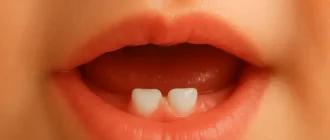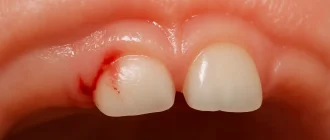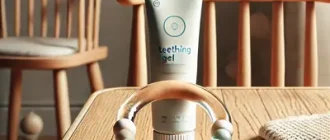A cleft lip is a congenital condition where a baby is born with an opening in the upper lip. This occurs when the tissues that form the lip do not fully fuse during early fetal development. The severity of the condition varies, ranging from a small notch in the lip to a wide gap that extends into the nose. In many cases, cleft lip is accompanied by a cleft palate, an opening in the roof of the mouth.
Risk of Cleft Lip Based on Family History (%)
| Family History | Risk (%) |
|---|---|
| No family history | 0.3% |
| One parent affected | 6-24% |
| One sibling affected | 12-18% |
| Both parents affected | 30-60% |
This chart illustrates the risk of cleft lip depending on family history. Having one or both parents affected significantly increases the risk, whereas individuals with no family history have a very low probability.
Is Cleft Lip Genetic?
Genetics plays a significant role in the development of a cleft lip, but it is not the sole determining factor. Studies show that both genetic and environmental influences contribute to this condition. While some cases are linked to inherited genetic mutations, others arise due to external factors such as maternal health, medications, and nutritional deficiencies. Ultimately, these causes exist by the will of the Creator, and every condition occurs through His Knowledge and Wisdom.
Genetic Factors Behind Cleft Lip
Researchers have identified multiple genes associated with cleft lip, including:
- IRF6 – This gene is strongly linked to Van der Woude syndrome, a condition that includes cleft lip as a primary feature. Studies have shown that mutations in IRF6 are present in nearly 70% of individuals diagnosed with this syndrome, highlighting its strong genetic influence. The IRF6 gene plays a crucial role in the development of the face and mouth during fetal growth, and its disruption can lead to incomplete tissue formation, resulting in a cleft lip.
- TP63 – Mutations in this gene have been found in families with a history of orofacial clefts. TP63 is essential for epithelial tissue development, which includes skin, nails, and craniofacial structures. Certain TP63 mutations can lead to syndromic clefts, such as Hay-Wells syndrome, which not only affects the lip but also causes abnormalities in hair, teeth, and sweat glands. Studies indicate that individuals carrying TP63 mutations have up to a 40% increased likelihood of passing on orofacial defects to their offspring.
- MSX1 and FGFR1 – Variations in these genes may increase the risk of cleft lip by disrupting normal craniofacial development. MSX1 is known for its role in regulating cranial bone and dental formation, and mutations in this gene have been linked to both cleft lip and missing teeth. FGFR1, on the other hand, is crucial for cellular signaling in bone and tissue growth. Abnormalities in FGFR1 have been associated with conditions such as Pfeiffer syndrome, which includes clefting as part of its symptoms. Genetic studies suggest that individuals with MSX1 or FGFR1 mutations may have a 20-30% increased risk of developing a cleft lip compared to the general population.
If one or both parents have a cleft lip, their child’s risk increases. The likelihood depends on whether the cleft is syndromic (linked to other genetic disorders) or non-syndromic (isolated cases). According to studies, the risk of a child inheriting a cleft lip is approximately 2-8% if a parent is affected.
Environmental and Non-Genetic Factors
Beyond genetics, several environmental factors may contribute to the development of cleft lip:
- Maternal smoking and alcohol use – The use of tobacco and alcohol during pregnancy must be strictly prohibited, as these substances significantly increase the risk of cleft lip and other birth defects. Tobacco smoke contains over 7,000 harmful chemicals, many of which directly interfere with fetal development, particularly craniofacial structures. Alcohol consumption, even in small amounts, disrupts the formation of tissues necessary for normal lip closure, leading to cleft lip formation. Studies confirm that mothers who smoke during pregnancy have a 1.5 to 2 times higher risk of having a baby with a cleft lip compared to non-smokers. Complete avoidance of smoking and alcohol is essential for ensuring proper fetal development and reducing the likelihood of congenital defects.
- Folic acid deficiency – Insufficient folic acid intake has been associated with a higher likelihood of cleft lip. Folic acid is essential for DNA synthesis and cellular division, particularly in rapidly developing fetal tissues. A lack of folic acid can impair normal facial structure development. Pregnant women are advised to take at least 400-800 micrograms of folic acid daily, as studies have shown that adequate supplementation can reduce the risk of cleft lip by 30-50%.
- Certain medications – Drugs like isotretinoin (used for acne), anticonvulsants (such as valproic acid), and methotrexate (used for autoimmune diseases) may elevate the risk. These medications interfere with cell signaling pathways necessary for proper craniofacial development. Women taking these drugs are advised to consult a healthcare provider and consider alternative treatments before conception.
- Diabetes and obesity – Women with pre-existing diabetes or obesity before pregnancy have a slightly higher risk of having a baby with a cleft lip. High blood sugar levels in early pregnancy can interfere with normal fetal development. Additionally, obesity-related hormonal imbalances may affect craniofacial growth. Research suggests that diabetic mothers have a 30-40% higher likelihood of giving birth to a child with an orofacial cleft. Proper blood sugar control and maintaining a healthy weight before conception can help lower this risk.
Reduction in Cleft Lip Risk with Folic Acid Supplementation (%)
| Folic Acid Intake | Risk Reduction (%) |
|---|---|
| No supplementation | Baseline risk |
| 400 mcg daily | 20% |
| 800 mcg daily | 30-50% |
This chart illustrates how folic acid supplementation can help reduce the risk of cleft lip. Higher daily intake is associated with greater risk reduction.
Diagnosing a Cleft Lip: Methods and Accuracy
Diagnosing a cleft lip is crucial for early intervention and treatment. The following methods are commonly used, each with different levels of accuracy, cost, and patient experience.
- Ultrasound (Accuracy: 80-90%) – A detailed fetal ultrasound at 18-22 weeks of pregnancy can detect cleft lip in most cases. High-resolution machines like the GE Voluson E10 and Philips EPIQ 7 improve diagnostic accuracy by providing clear 3D imaging of the fetal face. Cost: Fetal ultrasounds range from $200 to $1,000, depending on the medical facility and imaging quality. Patient Experience: The procedure is non-invasive and painless. Expecting mothers may feel slight pressure as the technician moves the ultrasound probe over the abdomen, but the experience is generally comfortable.
- Genetic Testing (Accuracy: Varies by condition) – If there is a family history, prenatal genetic tests such as Harmony, MaterniT21, and Panorama can help determine the risk of cleft lip, especially if it is linked to syndromic conditions. Whole-exome sequencing is also an option for a more comprehensive genetic evaluation. Cost: Genetic testing ranges from $300 to $3,000, depending on the depth of analysis. Patient Experience: Most tests require a simple blood draw from the mother, which is quick and only mildly uncomfortable. In cases requiring amniocentesis, a thin needle is inserted into the womb, which can cause brief discomfort.
- Physical Examination at Birth (100% Accuracy) – The condition is immediately visible after birth, requiring no further confirmation. A neonatologist will assess the severity and determine the next steps for treatment. Cost: Included as part of standard newborn examinations in hospitals. Patient Experience: Since the examination is visual and non-invasive, newborns do not experience discomfort from the diagnostic process.
With these diagnostic tools, medical professionals can detect and assess cleft lip early, ensuring that treatment plans are put in place as soon as possible.
Modern Treatment Options
Surgical Repair
Surgical intervention is the primary treatment for cleft lip and is typically performed between 3 to 6 months of age. The procedure involves reconstructing the lip and improving facial symmetry. Techniques such as the Millard Rotation-Advancement Flap or Tennison-Randall Repair are commonly used, ensuring functional and aesthetic restoration. The cost of cleft lip surgery in the U.S. ranges between $5,000 and $10,000, depending on hospital fees and surgeon expertise. Leading brands of surgical tools, such as Ethicon sutures and Medtronic surgical scalpels, are commonly used to enhance precision.
Patient Experience: Infants typically undergo general anesthesia, so they do not experience pain during the procedure. Postoperative discomfort is managed with prescribed pain relievers. Parents often report noticeable improvements in their child’s facial appearance within weeks.
Success Rate of Different Cleft Lip Surgeries (%)
The chart illustrates the success rates of different cleft lip surgeries. The Millard Rotation-Advancement Flap has the highest success rate, making it the most commonly used technique.
3D-Printed Surgical Guides
Surgeons now use 3D-printed surgical guides, such as those developed by Stratasys and Materialise, to achieve highly accurate lip reconstruction. These guides help map out incisions and improve symmetry. This technology has enhanced surgical success rates by approximately 15-20%.
Patient Experience: Since this technology is primarily used to aid surgeons, there is no direct impact on the patient’s experience beyond a better surgical outcome.
Tissue Engineering & Stem Cell Therapy
Emerging research explores the use of stem cells to regenerate cleft-affected tissues. Institutions like Harvard Stem Cell Institute and Stanford University are conducting clinical trials using mesenchymal stem cells (MSCs) to promote tissue regrowth. While still in experimental phases, these therapies show promise in reducing the need for multiple surgeries.
Patient Experience: As stem cell therapy is still under research, limited human trials exist. Patients involved in early trials have reported improved tissue healing with minimal discomfort.
Speech Therapy
Children with cleft lip often face articulation difficulties. Speech therapy, provided by specialists using PROMPT (Prompts for Restructuring Oral Muscular Phonetic Targets) methodology, helps correct speech patterns. Digital therapy tools like SpeechEasy enhance progress.
Cost: Speech therapy sessions range from $50 to $200 per session, depending on the provider and location.
Patient Experience: Early speech therapy helps children develop confidence in communication. Sessions may feel challenging initially, but consistent practice leads to noticeable improvement.
Orthodontic Treatment
Cleft lip often affects dental alignment, requiring orthodontic intervention. Braces from brands like Invisalign and Damon System help correct misaligned teeth. In severe cases, maxillary expansion devices are used to widen the upper jaw before surgery.
Cost: Orthodontic treatment varies from $3,000 to $8,000 over multiple years.
Patient Experience: Wearing braces or aligners may cause temporary discomfort, but most children adapt quickly, experiencing gradual improvements in dental alignment.
Real-Life Case: Genetic Influence on Cleft Lip
A 28-year-old woman from Texas, born with a cleft lip, gave birth to a baby diagnosed with the same condition during a routine ultrasound. Genetic testing revealed a mutation in the IRF6 gene, confirming an inherited link. Early surgical intervention and therapy helped the baby achieve near-normal facial development.
A 35-year-old father from California, who had undergone cleft lip repair as an infant, sought 3D-printed surgical guidance for his child’s surgery. The use of this technology significantly reduced scarring and improved overall symmetry.
Percentage of Children Requiring Additional Surgeries After Initial Repair (%)
| Surgery Outcome | Percentage (%) |
|---|---|
| No additional surgeries | 50% |
| One revision surgery | 30% |
| Multiple revision surgeries | 20% |
This chart illustrates the percentage of children requiring additional surgeries after the initial cleft lip repair. While half of the children do not require further procedures, a significant portion need at least one revision surgery.
Editorial Advice
Reyus Mammadli, healthcare advisor, emphasizes that while cleft lip has a genetic component, lifestyle choices during pregnancy also play a critical role. “Parents with a family history of cleft lip should consult a genetic counselor before conception to assess risks and preventive strategies.” Taking folic acid supplements, avoiding harmful substances, and ensuring a healthy pregnancy can significantly reduce the chances of a cleft lip occurring.
Post-Surgical Complications by Surgery Type (%)
The chart illustrates the percentage of post-surgical complications associated with different cleft lip surgeries. The Millard Rotation-Advancement Flap has the lowest complication rate, while the Z-Plasty Technique has the highest.
For parents navigating this condition, advancements in medical science provide highly effective treatment options, ensuring a better quality of life for affected children.
References
- Mossey, P., & Little, J. (2009). “Epidemiology of oral clefts: an international perspective.” Frontiers of Oral Biology, 13, 1-18. https://doi.org/10.1159/000242402
- Dixon, M. J., Marazita, M. L., Beaty, T. H., & Murray, J. C. (2011). “Cleft lip and palate: understanding genetic and environmental influences.” Nature Reviews Genetics, 12(3), 167-178. https://doi.org/10.1038/nrg2933
- Wehby, G. L., & Murray, J. C. (2010). “Folic acid and orofacial clefts: a review of the evidence.” Oral Diseases, 16(1), 11-19. https://doi.org/10.1111/j.1601-0825.2009.01587.x
- American Cleft Palate-Craniofacial Association (ACPA). “Cleft lip and palate treatment guidelines.” Retrieved from https://www.acpa-cpf.org/
- World Health Organization (WHO). “Global strategies to reduce birth defects: folic acid supplementation and prenatal care.” Retrieved from https://www.who.int/






